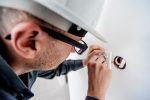Have you ever thought of the importance of electricity and how it impacts our lives?
Without it, our lives would be completely different and so much harder in every way.
So, since it’s so easy to forget all the advantages we have with electricity, we have made this article.
Here, we’ll talk about how our use of electricity provides us with health, safety, and abundance.
Let’s begin with the most apparent places where electricity puts a huge impact: our homes.
Households
Electricity has been the most revolutionary in homes.
According to EIA, more than 37% of electrical retail sales are residential, which makes this consuming sector the largest.
Today, houses use over 12 times more electricity than in the mid-20th century, which is about 1.4 trillion kilowatt-hours annually.
So, what does it imply?
Let’s enumerate the ways electricity benefits our households.
Refrigeration and Heating
Refrigeration and cooling systems together use about a quarter of electricity in this sector.
Before that, people used handheld fans to cool off and pantries and safes to store food.
To prevent the meat from spoiling, it was either dried or salted.
Today, we use refrigerators, freezers, vents, rotating fans, and cold water to handle the heat.
Similarly, electricity keeps our homes warm in the winter, so we don’t have to burn fires and use thick blankets.
Back in the day, if you wanted a hot bath, you would heat the water over flames first.
Now, you can just turn on the tap and it’ll automatically pour hot water into the bathtub.
Ironing was also a challenge back then.
Charcoal irons were used with the coals heated separately.
Lighting
Another benefit of electricity is lighting.
People don’t have to rely on candles, gas lamps, roaring fires, and kerosene lamps any longer to be able to read, eat, or bathe at night.
According to ClickEnergy, a light bulb of 60 watts produces as much light as 100 candles.
With that, we can work late without harming our eyes, read books, and play games until late into the night.
We also don’t have to worry about tripping over during every visit to the bathroom at night.
Lighting makes up about 9% of residential electricity.
Hygiene
With electricity, we can wash and dry our clothes without the need for washboards and clotheslines.
We can also now shave with electric razors, as well as cosmetic devices that help us look good, such as curling irons or blow dryers.
Gadgets
As we now live in a technologically advanced world, electricity makes it possible to use our gadgets.
Through it, we can charge our phones, tablets, smartwatches, and even cars.
Food Industry
Another sector that benefits from electricity is the food industry, particularly in its production, distribution, and preparation.
Agriculture
Since the 19th century, electricity was used in farms for grinders, hay lifts, and threshers.
Today, it’s used for almost everything, including pumps, fans, and lights.
Electric fencing makes it easier to contain livestock.
Also, with massive efficiency boosts in the agricultural sector, we can benefit from the convenience of fast food.
Kitchen Appliances
With electricity, cooking changes drastically.
From ancient times to the 19th century, people cooked meals with fire.
Then, electric stoves and ovens, toasters, and microwaves were introduced.
Before, bakers had to use manual mixers to prepare the dough since they didn’t have appliances.
Firewood was used in ovens, and it had to be chopped, hauled, and stacked regularly.
Even if you needed to boil some water, you’d need to start a fire.
With electricity, that all changed, and cooking became more convenient.
According to QZ, scientists from Finland are even working on ways to create food directly out of electricity.
If this research succeeds, it will make food affordable, possibly solving a large share of world hunger.
Businesses
Every part of the world economy depends on electricity.
As The Guardian reports, 3% of the GDP of Africa is eliminated due to energy supply problems.
There’s really not much that can be done or made without electricity.
Commercial Sector
In the U.S., the commercial sector—from retail to telecommunications—relies on electricity to keep offices lit, cooled, or heated.
Similar to the residential sector, refrigeration and heating comprise a large part of energy use in businesses.
According to EIA, it amounts to 25% of commercial electricity.
Another 15% are used by office computers, equipment, etc.
According to Renewable Energy World, copiers, fax machines, and workstations use their share of electricity.
The commercial sector uses almost 37% of retail electricity in the U.S.
Manufacturing Sector
In the manufacturing sector, about 25% of retail electricity is used.
Almost 50% of electricity in the manufacturing sector is used by machines.
Another 14% are used in boiler and heating processes.
Almost 10% is consumed by heating, cooling, and ventilation systems.
About 6 to 7% of industrial electricity goes to lighting, cooling and refrigeration, and electrochemical processes.
Without electricity, the manufacture of complex products such as TV sets or vehicles would be impossible.
In the early 19th century, workers would work hard to perform just a part of the job that machines do today quickly.
Telecommunications
One of the things that electricity does the best is move information.
Feeble amounts of electricity make it possible to access entire libraries from all over the world right away, from one computer to another.
The information is intangible, so it can’t be easily destroyed, unlike it was in the past.
It also makes it cheap to modify and copy.
With smartphones, we have access to the internet for hours without the need for charging.
And they allow us to keep in touch with anyone in the world at a low cost.
Transportation
Up until the last several decades, transportation was dependent solely on gas and coal.
In this sector, the use of electricity is still low.
According to the EIA, it consumes 0.2% of retail electricity.
The most popular type of electric transportation is electric trains.
But now, there are also cars, trucks, bikes, buses, rickshaws, motorcycles, scooters, and airplanes that run on electricity.
There are also hybrid vehicles that use both electricity and gas creating a nice balance between cleanliness and efficiency.
Electricity has also allowed using multiple streetlights, promoting road safety and traffic control as well as the safety of flights.
Entertainment
Boredom used to be a common thing everywhere.
Only a century ago, people used newspapers, novels, anecdotes, and occasional opera or play visits for entertainment.
Then, with the rapid development of technology, radio broadcasts, film-making, television, arcade games, and personal computers have been developed.
Now, there’s more entertainment than we can handle—the internet, video games, social media, TV channels, streaming services, and so much more.
Even older entertainment types came back in new forms.
Radio broadcasts became podcasts, novels can be read on electronic devices, and comics became digital.
Even the printing developments made old-fashioned printed books more accessible and durable.
With improvements to audio equipment, music became easier to record and perform.
According to EIA, almost 6% of residential electricity is used to power television and similar equipment, and over 2% power computers.
Education
With electricity, learning is more efficient than ever before.
Advancements in printing enable teachers to provide every student with the same high-quality books.
With various electronic equipment, such as televisions, projectors, and computers, information can be presented more vividly.
Additionally, students with hearing problems can benefit from electronic hearing aid devices to fully absorb lectures.
Also, cloud storage made turning in and organizing assignments extremely straightforward.
The integration of the internet in the classroom is also a huge advantage since students can listen to lectures and do tasks on shared platforms.
With this, preparing lessons according to the student’s strengths and monitoring their progress is much easier.
Healthcare
The healthcare area has had significant developments over a few hundred years.
Today, so much medical equipment depends on electricity: ventilators, medical monitors, incubators, X-ray machines, ultrasound, etc.
In most hospitals, patient records are also stored electronically, making documentation more consistent and durable.
In the past, mistakes in the documents could be unnoticed for the entire life of the patient.
Now, medical software can detect and flag potential inaccuracies.
Even drug conflicts can be detected.
Also, some people predict that soon medical equipment will be able to make most medical decisions on its own.
This page is also available in Spanish.










